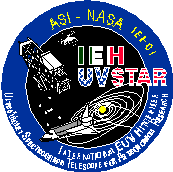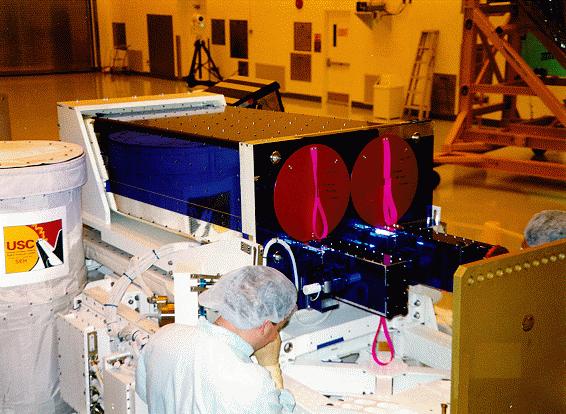 UVSTAR Overview
UVSTAR Overview
UVSTAR is a pair of telescopes with imaging spectrographs that are sensitive to EUV and FUV
wavelengths. From the Space Shuttle, UVSTAR will form spectrally resolved images of
extended emission regions such as the Io plasma torus. It is being prepared for flight jointly by
the Lunar and Planetary Laboratory (University of Arizona) and the Center for Advanced
Research in Space Optics (University of Trieste, Italy). Observing time will be shared to
achieve objectives in both planetary science and stellar astronomy. UVSTAR offers an
important advantage for torus research, namely the capability to form simultaneous images of
the torus in each of its brightest emission lines. The spectral dispersion is great enough to
separate images of most of the important emissions, leading to easy analysis without
deconvolution.
Schedule and Flight Opportunities. The electronics and mechanical structure for UVSTAR
are complete and will be delivered to GSFC in January 1995. The electronics package is the
same as that of the University of Arizona's GLO instrument which was sponsored by the
USAF/Phillips Laboratory. Fabrication of the mechanical structure was contributed by our
Italian partners. UVSTAR is manifested for its first flight on STS-69 in July 1995, and for four
reflights at 13-month intervals.

Plasma Torus Studies
The EUV spectrum of the plasma torus is rich in information about the ion composition,
density, and electron temperature of the plasma. Spectral and morphological studies bear
directly on such fundamental questions as the energy and mass budgets of the torus. Azimuth
al asymmetries in the torus relate not only to localized torus-magnetosphere interactions, such
as the Io-related brightness enhancement, but also to large-scale magnetospheric phenomena
involving plasma flow in Jupiter's magnetotail. Although ground-based studies of torus
emissions at visual wavelengths have added much to our knowledge of this plasma, measure
ments in the EUV offer a more direct means of studying certain processes in the torus. Recent
EUV measurements (the only since those of the Voyager UVS) by the Hopkins Ultraviolet
Telescope and the Extreme Ultraviolet Explorer have emphasized the importance of this
wavelength range. However, the former instrument lacks imaging capability, and the latter has
substantially lower spatial resolution and is less sensitive to the most diagnostic wavelengths
than UVSTAR.
- Studies of the plasma torus have demonstrated that
- · Observations in the EUV range are essential,
- · Full spectral coverage of this range is required, and
- · Extensive morphological studies, i.e. imaging of the entire system is needed.
UVSTAR provides all these capabilities. It will complement and extend observations by
Galileo. Galileo's orbital geometry limits its opportunities for viewing the plasma torus with
the UV instruments, and especially with the EUV spectrograph. UVSTAR will provide
observations of the Jovian system at improved spectral resolution.
The imaging spectrographs will measure the intensity of several important emission lines
of S II, S III, S IV, and O II as a function of position and time in the torus, measure H2 bands
and H Lya from Jupiter's dayglow and aurora, and possibly help to clarify the coupling
between the torus and the aurora. All these emissions and full spatial coverage will be
recorded simultaneously.
The spectrographs, when operating with wide slits, form two-dimensional images of a
spatially-extended target within the slit. Images at different emission lines are displaced in the
dispersion direction. The dispersion is great enough to separate monochromatic images of the
torus at a number of wavelengths. During one orbit UVSTAR will record torus emissions for
about 30 minutes, giving an image that can be analyzed to determine the morphology of
several of the strong emission lines. The spatial resolution over the disk of the planet (~0.15 Rj)
will separate polar and equatorial emissions of H2 and H Lya.
UVSTAR Hardware
The UVSTAR optics section consists of two nearly identical telescopes and imaging
spectrographs mounted on an articulated platform. The telescope mirrors are off-axis
paraboloids having diameters of 30 cm and focal lengths of 1.4 m. They are coated with
silicon carbide for good EUV reflectivity, and their mounting is thermally compensated to
maintain focus. The spectrographs are similar to units successfully flown on several University
of Arizona Shuttle instruments. They have slits of length 0.25 and selectable slit widths
summarized in the table below.
Narrow ----3 pixels ----- 9 arcsec ------1 Å : Best spectral resolution
Medium ---13 pixels -----39 arcsec -----4 Å : Global images of Jupiter
Wide ----- 33 pixels ----100 arcsec ----12 Å : Encompasses entire torus
The spectrographs cover wavelength ranges of 500-850 Å and 800-1250 Å. Their holographical
ly fabricated concave gratings are aberration corrected, and image on a flat focal surface over
the area of the detector.
Detectors.
The detectors are intensified CCDs similar to those used in earlier University of
Arizona Shuttle instruments. They consist of proximity-focussed windowless intensifiers fiber-
optically coupled to CCDs for readout. These 2-D imaging detectors are sensitive to single
photoevents. The CCDs are 1152 × 298 pixel arrays (dispersion × spatial dimensions), and the
readout format can be controlled electronically.
Finding and Tracking.
UVSTAR includes capabilities for independent target acquisition
and tracking. Rough pointing will be provided by orienting the Orbiter. The finder telescope
will locate the target and move the optical axis to it. Pointing control will then be transferred
to the tracker telescope. A computer-controlled digital feedback system will hold the UVSTAR
on target by cancelling the Orbiter's attitude control motions. The internal gimbals allow ±3
motion about each of two axes.
Telemetry.
Command uplink and real-time data downlink telemetry permit good control
of the experiment. Ground commands are transmitted over a 1200-baud uplink, and the data
downlink consists of two medium-rate channels operating at 60 kBytes/sec for real-time data
and 120 Kbytes/sec for playback of recorded data. UVSTAR stores records data on its optical
disk during periods when the data downlink is not available.
Bill R. Sandel
A. Lyle Broadfoot
16 December 1994
 Click the icon to leave any comments or suggestions you may have.
Click the icon to leave any comments or suggestions you may have.
 Back to LPL-West
Spaceflight page
Back to LPL-West
Spaceflight page
Last Updated: 09 December 1994
This page is maintained by:
Jesus A. Ramirez
(ramirez@argus.lpl.arizona.edu)
 UVSTAR Overview
UVSTAR Overview UVSTAR Overview
UVSTAR Overview
 Click the icon to leave any comments or suggestions you may have.
Click the icon to leave any comments or suggestions you may have. Back to LPL-West
Spaceflight page
Back to LPL-West
Spaceflight page